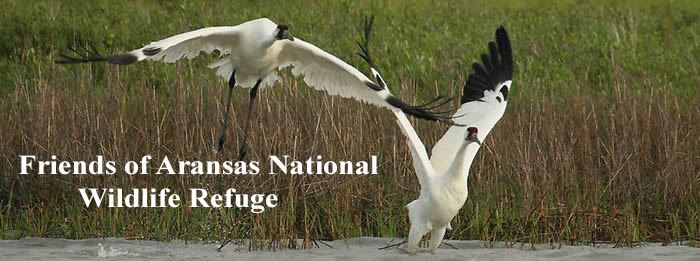Wintering Whooping Crane Update, April 7, 2017
Wade Harrell, U.S. Whooping Crane Recovery Coordinator
Whooping crane spring migration is in full swing. It has been another tremendous winter season here at Aransas NWR, but the whooping cranes are ready to get back up to Wood Buffalo National Park for another breeding season.
As of yesterday, of 7 birds that have active satellite transmitters, 5 have departed Aransas NWR. Quivira NWR (Kansas) and surrounding areas seem to be a hotspot for stopovers this fall, with a group of 14 whooping cranes reported last week and a group of 8 reported this week as well as sightings of smaller groups. There have also been a number of whooping cranes reported in the Platte River in Nebraska and a number that have already made it to the Dakotas. Here in Texas, 2 marked whoopers were spotted on Ft. Hood Army Base this past week. The number of whooping cranes at Aransas will quickly dwindle over the next couple weeks. Spring migration is typically shorter in duration than fall migration, usually only taking about 30 days.
As soon as results from the Annual Whooping Crane Winter Abundance Survey are complete, we will post a summary on the Aransas NWR website.
Whooping Cranes on the Refuge
Cranes have recently been seen from the observation tower on the Refuge, but it’s difficult to say how much longer they will remain. But there are many other interesting wildlife species to view at the Refuge now, including many spring migrating songbirds, so don’t hesitate to come out and enjoy other spring wildlife watching opportunities.
Texas Whooper Watch
Please report any whooping cranes you observe in migration in Texas to Texas Whooper Watch. We’ve had a number of people making use of the new Texas Whooper Watch I-Naturalist phone app as well, which is encouraging. The old saying “a photo is worth a thousand words” applies to reporting whooping cranes as well. Just be careful not to disturb or get too close the birds!
Habitat Management on the Refuge
Refuge staff burned 4 Units this winter, totaling 4,871 acres. This year's winter season was challenging given that our cold weather windows with consistent north winds were limited and the latter part of the winter brought significant rains.
Precipitation/Salinity
The Refuge received 6.16” of rain from January-March 2017. Freshwater levels and food resources remained high throughout most of this winter season. Salinity levels in San Antonio Bay stayed in the low teens (ppt) most of the winter, but recent rains in the middle portion of the Guadalupe river watershed have dropped salinities significantly this last week. Let’s hope we stay in a wet cycle for a bit longer.
